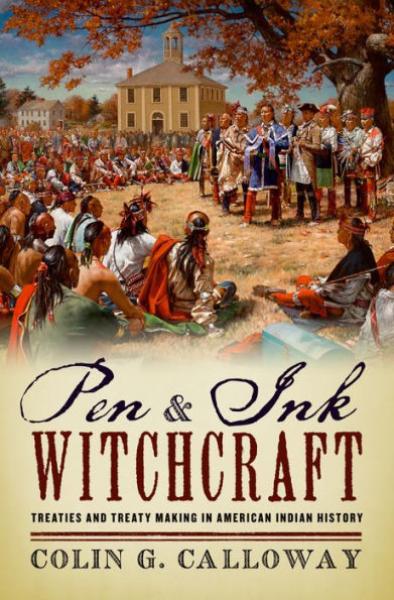Description
In Pen and Ink Witchcraft, eminent Native American historian Colin G. Calloway narrates the history of diplomacy between North American Indians and their imperial adversaries, particularly the United States. Treaties were cultural encounters and human dramas, each with its cast of characters and conflicting agendas. Many treaties, he notes, involved not land, but trade, friendship, and the resolution of disputes. Far from all being one-sided, they were negotiated on the Indians' cultural and geographical terrain. When the Mohawks welcomed Dutch traders in the early 1600s, they sealed a treaty of friendship with a wampum belt with parallel rows of purple beads, representing the parties traveling side-by-side, as equals, on the same river. But the American republic increasingly turned treaty-making into a tool of encroachment on Indian territory. Calloway traces this process by focusing on the treaties of Fort Stanwix (1768), New Echota (1835), and Medicine Lodge (1867), in addition to such events as the Peace of Montreal in 1701 and the treaties of Fort Laramie (1851 and 1868). His analysis demonstrates that native leaders were hardly dupes. The records of negotiations, he writes, show that Indians frequently matched their colonizing counterparts in diplomatic savvy and tried, literally, to hold their ground.
Each treaty has its own story, Calloway writes, but together they tell a rich and complicated tale of moments in American history when civilizations collided.
Calloway's analytical framework is sound; his command of the events and personalities involved in the negotiations he examines is masterful; and his larger conclusions about the devestating impact of treaties and treay-making on North America's Native people are convincing [and] sobering.--Kansas History: A Journal of the Central Plains
In a comprehensive survey of 'hybrid diplomacy' across a kaleidoscopic diplomatic landscape, Calloway guides his readers through Native negotiations with British, French, Spanish, and American colonial governments. Orators, politicians, interpreters, and scalawags inhabit these lively pages as Calloway illuminates how each side brought its history, ritual, protocols, and expectations to the table. From the 1768 Treaty of Fort Stanwix to musings on the contemporary legal arguments and public opinions that swirl around treaties, Pen and Ink Witchcraft is a must-read account by a superbly accomplished historian.--K. Tsianina Lomawaima, author of To Remain an Indian: Lessons in Democracy from a Century of Native American Education
Colin Calloway has done it again. With expansive coverage and insight, Pen and Ink Witchcraft historicizes American Indian treaty-making within the currents of North American imperial history and underscores the centrality of American Indians in the diplomatic history of the United States. A powerful achievement.--Ned Blackhawk, author of Violence over the Land: Indians and Empires in the Early American West
Indian treaties were major historical events, and today they are still important sources of legal rights. Pen and Ink Witchcraft is a masterful overview of the complex processes by which these treaties were created.--Stuart Banner, author of How the Indians Lost Their Land: Law and Power on the Frontier
This extraordinary analysis of Indian treaties and treaty-making reveals the complexity and objectives of the United States government in negotiating nearly 400 ratified agreements. In a book wide in scope--addressing political ceremony, kinship alliances, council meetings, native law, oratorical power, gift-giving diplomacy, and sovereignty--Colin Calloway has produced a masterpiece for Indian treaties to be understood by everyone. This leading scholar of Indian history explains the historical development of Native American legal rights today.--Donald L. Fixico, editor of Treaties with American Indians: An Encyclopedia of Rights, Conflicts, and Sovereignty
Product Details
- Oxford University Press, Brand
- Oct 1, 2014 Pub Date:
- 0190206519 ISBN-10:
- 9780190206512 ISBN-13:
- 377 Pages
- 9.1 in * 6.1 in * 1 in Dimensions:
- 1 lb Weight:




